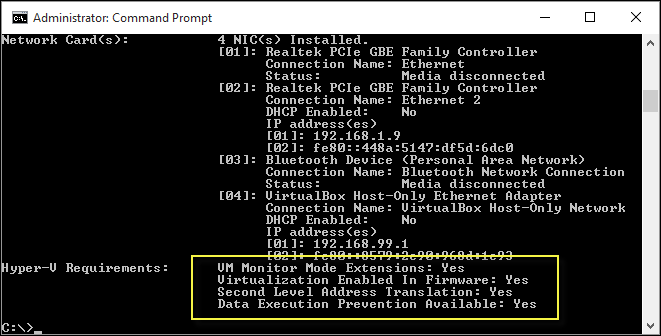System requirements for Hyper-V on Windows and Windows Server
Hyper-V has specific hardware requirements, and some Hyper-V features have other requirements. Use the details in this article to decide what requirements your system must meet so you can use Hyper-V the way you plan to.
Then, review the Windows Server catalog. Keep in mind that requirements for Hyper-V exceed the general minimum requirements for Windows Server because a virtualization environment requires more computing resources.
If you're already using Hyper-V, it's likely that you can use your existing hardware. The general hardware requirements have changed minimally from Windows Server 2012 R2. But, you need newer hardware to use shielded virtual machines or discrete device assignment. Those features rely on specific hardware support, as described below. Other than that, the main difference in hardware is that second-level address translation (SLAT) is now required instead of recommended.
For details about maximum supported configurations for Hyper-V, such as the number of running virtual machines, see Plan for Hyper-V scalability in Windows Server. The list of operating systems you can run in your virtual machines is covered in Supported Windows guest operating systems for Hyper-V on Windows Server.
Operating system requirements
Hyper-V can be enabled on these versions of Windows:
- Windows 10 Pro or Enterprise
- Windows 11 Pro or Enterprise
General requirements
Regardless of the Hyper-V features you want to use, you need:
A 64-bit processor with second-level address translation (SLAT). To install the Hyper-V virtualization components such as Windows hypervisor, the processor must have SLAT. However, it's not required to install Hyper-V management tools like Virtual Machine Connection (VMConnect), Hyper-V Manager, and the Hyper-V cmdlets for Windows PowerShell. See How to check for Hyper-V requirements to find out if your processor has SLAT.
VM Monitor Mode extensions
Enough memory. Plan for at least 4 GB of RAM. More memory is better. You need enough memory for the host and all virtual machines that you want to run at the same time.
Virtualization support turned on in the BIOS or UEFI:
Hardware-assisted virtualization. This is available in processors that include a virtualization option; specifically processors with Intel Virtualization Technology (Intel VT) or AMD Virtualization (AMD-V) technology.
Hardware-enforced Data Execution Prevention (DEP) must be available and enabled. For Intel systems, this is the XD bit (execute disable bit). For AMD systems, this is the NX bit (no execute bit).
How to check for Hyper-V requirements
Open Windows PowerShell or a command prompt and type:
Systeminfo.exe
Scroll to the Hyper-V requirements section to review the report. If all listed Hyper-V requirements have a value of Yes, your system can run the Hyper-V role. If any item returns No, check the requirements listed in this document and make adjustments where possible.

Requirements for specific features
This section lists the requirements for discrete device assignment and shielded virtual machines.
Discrete device assignment
Host requirements are similar to the existing requirements for the SR-IOV feature in Hyper-V.
The processor must have either Intel's Extended Page Table (EPT) or AMD's Nested Page Table (NPT).
The chipset must have:
Interrupt remapping - Intel's VT-d with the Interrupt Remapping capability (VT-d2) or any version of AMD I/O Memory Management Unit (I/O MMU).
DMA remapping - Intel's VT-d with Queued Invalidations or any AMD I/O MMU.
Access control services (ACS) on PCI Express root ports.
The firmware tables must expose the I/O MMU to the Windows hypervisor. This feature might be turned off in the UEFI or BIOS. For instructions, see the hardware documentation or contact your hardware manufacturer.
Devices need GPU or nonvolatile memory express (NVMe). For GPU, only certain devices support discrete device assignment. To verify, see the hardware documentation or contact your hardware manufacturer. For details about this feature, including how to use it and considerations, see Discrete Device Assignment--Description and background in the Virtualization blog.
Shielded virtual machines
These virtual machines rely on virtualization-based security and are available starting with Windows Server 2016.
Host requirements are:
UEFI 2.3.1c - supports secure, measured boot
The following two are optional for virtualization-based security in general, but required for the host if you want the protection these features provide:
TPM v2.0 - protects platform security assets
IOMMU (Intel VT-D) - so the hypervisor can provide direct memory access (DMA) protection
Virtual machine requirements are:
- Generation 2
- Windows Server 2012 or newer as the guest operating system
Final Check
If all OS, hardware and compatibility requirements are met then you see Hyper-V in Control Panel: Turn Windows features on or off and it has 2 options.
- Hyper-V platform
- Hyper-V Management Tools
Note
If you see Windows Hypervisor Platform instead of Hyper-V in Control Panel: Turn Windows features on or >off your system may not be compatible for Hyper-V, then cross check above requirements. If you run systeminfo on an existing Hyper-V host, the Hyper-V Requirements section reads:
Hyper-V Requirements: A hypervisor has been detected. Features required for Hyper-V will not be displayed.